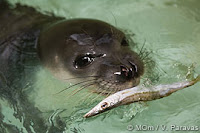
Ok, so some of us get a bit confused about 9 o’clock vs. 3 o’clock, 8 o’clock vs. 2 o’clock, but we yell it out with great enthusiasm! My favorites from our group were the “Over there, by the bird!” and “Look, by the blue buoy!” Fortunately, Joan (almost always) kept a sense of humor about our novice ways. It was an incredible week and I am sad to see it come to an end — even two days of rain couldn’t dampen our spirits or our opportunities to experience the amazing bottlenose dolphins of the gulf. To see newborns and juveniles and their protective moms was beyond description. My favorite “moment” (of many wonderful moments) was to sit quietly amongst a large group of dolphins, to listen to their breathing, to the unique sounds they make as they feed, and to hear and see how they communicate and coordinate with one another. Nothing can compare; it was an almost mystical experience that I wished could continue for hours. I have learned much not only about the dolphins, but also about the complex interrelationships between fishing practices, pollution, fish farms, and the survival of the many species in our oceans. Thank you, Joan, for being such a great teacher and for your passion. The work Tethys and Earthwatch are doing will make such a difference. Thanks also for the opportunity to be a very small part of your efforts. I highly recommend this trip to anyone with interest in dolphins and our oceans!
Lynda, USA
---
Just to have the opportunity to be on the water in this gorgeous location is a pure pleasure, but this total experience exceeded my expectations in all regards. To be surrounded by feeding dolphins while seagulls circled overhead and terns dive-bombed for fish was a magical experience I will never forget. I leave this trip with an increased respect for both the research and the researcher—how Joan could drive the boat while answering questions and at the same time manage to photograph all those animals was awesome. We now know how difficult it can be to identify an individual dolphin, but then Joan made it look so easy. When he could instantly identify a totally unmarked dorsal fin as the juvenile offspring of “Gindra” it made me realize how well he knows the 150 dolphins of Amvrakikos Gulf. And the sea turtles on the last day were amazing! The video selection was a good thing. Never before have I considered what the fish eat that I consume. More “food for thought...” Five people who had never previously met managed to form a good team. I thought I would die when I realized we would actually need to PLAN the meals as well as cook and clean, but that, too, turned out to really contribute to working as a group. Finally, Posi was much appreciated, because every once in a while you really need to pet a dog!
Karin, USA
---
I thought I had made a mistake to come to Vonitsa after I filled out the enrollment forms. I felt I was joining a boot camp, but my experience in Vonitsa turned out to be pleasant and exciting. I learned a great deal about the research done with the dolphins and turtles. The videos shown were informative and mind awakening. I learned more than I had expected and I am glad I came. Joan is very serious with the training and research, which is very important for the type of work done. I am confident and trust that my contribution was for a great cause and effort. I understand the results of this research are made public to the Vonitsa’s community. It is critical to bring awareness to and get people involved in the project, so they feel part of this effort (it is their town), bring possible solutions, and make the project successful. Thank you to ALL of you for doing this job and for bringing awareness of this wonderful world of the dolphins.
Lilia, USA






















